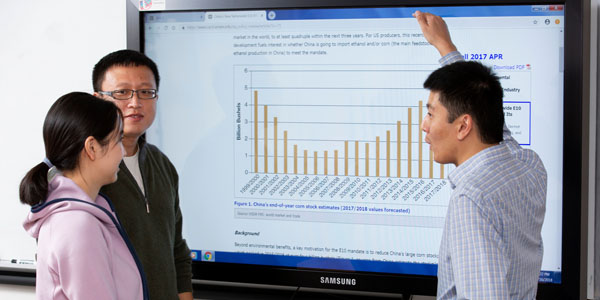
Collaborating on China’s Economy
A new center at Iowa State University is working to advance knowledge of China’s trade policy and agricultural markets.
The Center for China-US Agricultural Economics and Policy was created in April 2017 by the Center for Agricultural and Rural Development at Iowa State. The center has forged a partnership with the Chinese Academy of Agricultural Sciences and Iowa State experts to get access to information about Chinese agriculture and to clear the path for Chinese students to study economics in the United States.
“Until this partnership started, we didn’t have access to good data that existed in China,” says Dermot Hayes, Charles F. Curtiss Distinguished Professor in Agriculture and Life Sciences and former interim director of the center. “Their public data for years has had quality problems, but now we have access to better data and to people who understand the agricultural industry in China.”
John Crespi, professor of economics and interim director of the center, Hayes, Wendong Zhang, assistant professor and extension economist, Minghao Li, postdoctoral researcher, and Yongji Ji, assistant scientist, are Iowa State staff of the center. Currently, they are hosting three visiting scholars from China: Yue Hu, Wenting Wang and Chuqiao Peng.
The partnership is already starting to pay dividends.
The center conducts research and outreach in the areas of trade, agricultural markets and policy. It publishes academic journal articles as well as policy briefs on key Chinese agricultural markets and issues geared toward both U.S. and Chinese policymakers, industry stakeholders and media.
“China is so big that the things they do domestically, let alone who they decide to buy from internationally, have strong implications for what producers in the U.S. are able to sell,” says Zhang. “Those are things we care about very much.”
The partnership also is beneficial to Chinese scholars by providing them a place to come and work. The center hosts researchers and doctoral students who conduct research of their own.
“Typically, these students would come to the U.S. and study our agricultural economy, but now they are able to come over and study Chinese agriculture,” Hayes says. “They are able to help analyze the data and provide better context, which has helped us learn a tremendous amount.”
Knowledge of the inner workings of the Chinese economy can help U.S. farmers and economists spot emerging markets or other trade opportunities.
“China has produced 97 percent of the pork they consume internally, meaning they only import 3 percent from Europe or the U.S.,” says Zhang. “But there has been an outbreak of African swine flu in the country, so imagine if their imports now increase from 3 to 5 percent? That is a very large market for producers in the U.S. This is interesting to us because China is no longer a developing country that needs technology and infrastructure as it was 20-30 years ago. They are now a country whose domestic decisions have real consequences internationally.”
##
UPDATE: JULY 12, 2019
The Center for Agricultural and Rural Development has published articles including African Swine Fever in China: An Update, Seven things you need to know about China to better understand the US-China trade war, and The impact of the 2018 Trade Disruptions on the Iowa Economy.



